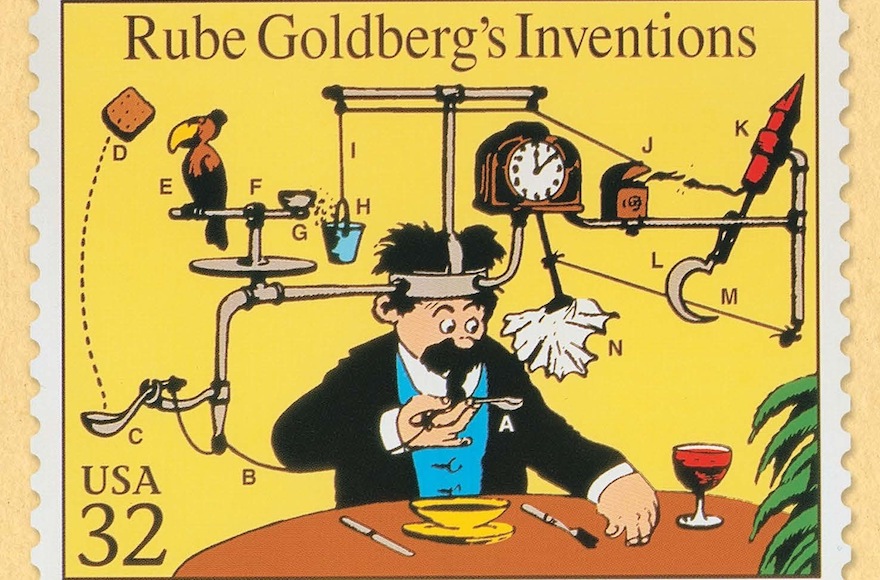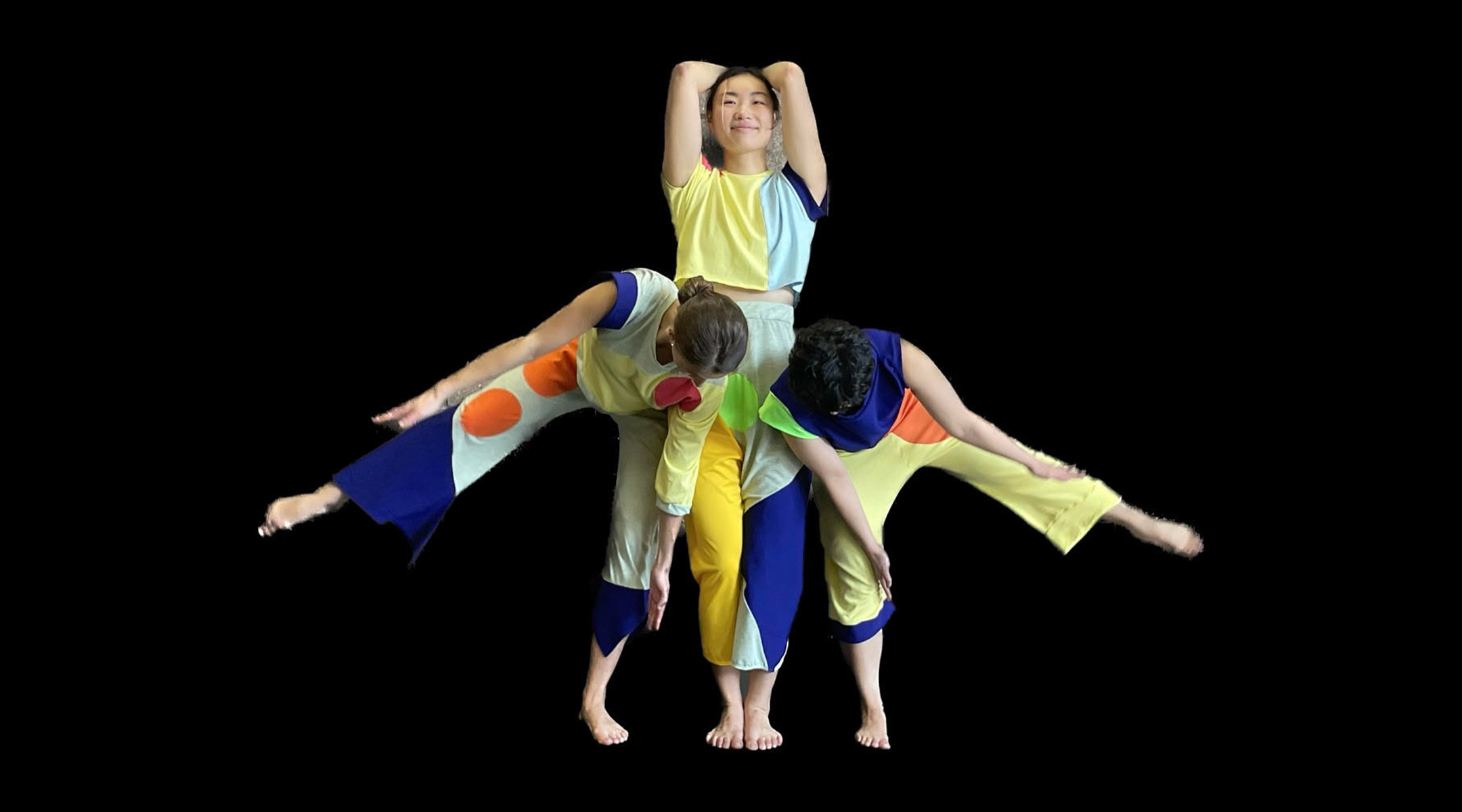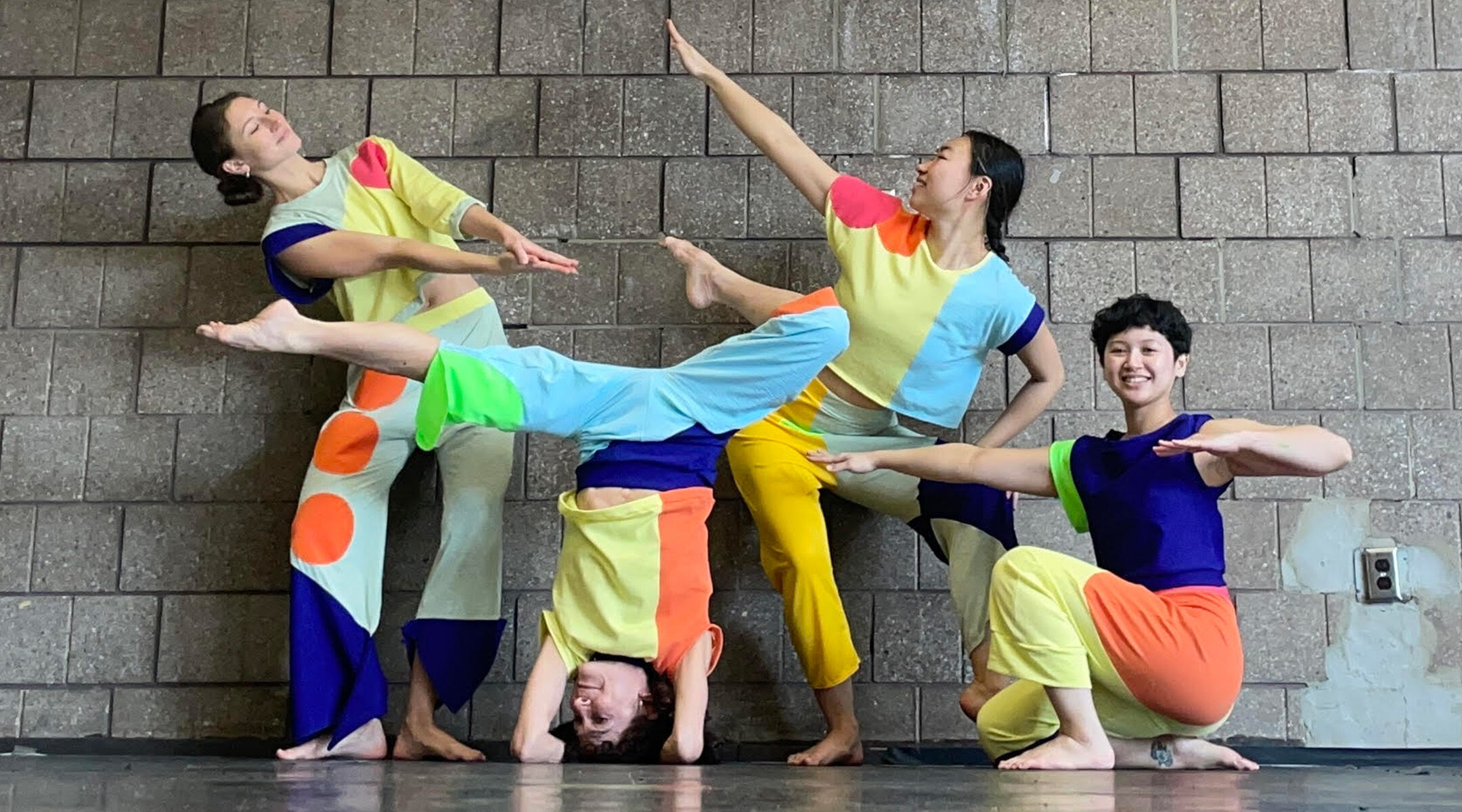(New York Jewish Week) — Are we humans all parts of a meticulously crafted machine? Or are we independent beings, chaotically disrupting one another’s trajectories through time and space? Is there a difference between intentional and unintentional impact? Does it matter whether our movements are prompted by internal or external forces?
These are just some of the questions that surfaced as I watched footage of “Rube G.-The Consequence of Action,” a new work by acclaimed New York-based choreographer and dancer Jody Oberfelder. The piece — at once whimsical and thoughtful — explores the mechanical motions inherent in a classic “Rube Goldberg machine” (a chain-reaction contraption that typically involves levers swinging, cogs twirling, bits and bobs knocking each other on predetermined courses) as expressed through the human form.
Over four years in the making, the piece will make its debut March 4 at the Agnes Varis Performing Arts Center in Lower Manhattan. It will be performed for three consecutive weekends, culminating in a gala event on March 19.
The genesis of this 50-minute piece began four years ago, when musician Frank London of The Klezmatics was organizing an event celebrating 15 Jewish thinkers and creators — from philosopher Hannah Arendt to composer Morton Feldman — at the New York Public Library. Oberfelder, a director, choreographer and filmmaker dedicated to site-specific works that “expand how one experiences dance,” was invited to create a piece inspired by the work of Rube Goldberg (1883-1970), the Jewish cartoonist who drew his eponymous machines starting with Collier’s Weekly magazine in 1929. According to the Rube Goldberg Institute for Innovation and Creativity, these machines “solve simple problems in the most ridiculously inefficient way possible.” A classic example is the “Self Operating Napkin,” which wipes an eater’s face by using a combination of strings, counterweights and even a scythe.
Oberfelder was intrigued and, initially, a bit surprised by the assignment. “[Frank] said, ‘God, you’re Rube Goldberg! This is perfect for you!’ But it wasn’t until I started going deeply into research that I realized [he was right],” Oberfelder told the New York Jewish Week.
Oberfelder has had a long and illustrious career: She’s danced with and for the likes of composer Meredith Monk and choreographer Sally Silvers, and has traveled the world as a performer, guest choreographer and lecturer, from the University of Hawaii to London’s Victoria and Albert Museum. Still, this new prompt captivated her. “I realized we’ve been living the Rube Goldberg life all along,” she said, referencing the ways in which people are all tied together, an intricate array of human cogs. Soon, she was hooked on the ideas behind Goldberg’s fanciful genius.

An iconic Rube Goldberg cartoon, the “Self Operating Napkin,” was featured on a U.S. postal stamp honoring the cartoonist. (Rube Goldberg Inc.)
The resulting piece for the NYPL event was, according to Oberfelder, “a four-minute blast” that explores this idea. “We were running through the audience,” she told me, remembering that first dive into the world of order and chaos that is Goldberg’s philosophy. “[It seems like] a whole lot of something for nothing. But it is something — the joy of the moment to moment, while a marble is rolling down a slide, knowing that it [was there] and it worked.”
After that initial performance, Oberfelder wanted to explore more but, of course, the pandemic soon swept away any performance plans. Inventive as ever, she took the ideas she’d workshopped for London and created a second iteration: a film that combined over 300 clips of dancers responding to prompts like “spin” and “pop up.” Dancers and laypeople the world over, despite the social isolation, came together into a global Rube Goldberg machine.
Eventually, as COVID-19 restrictions lifted and the world began to open up, she took her new understanding of the themes and translated the film into a site-specific work that showed at Roulette, a Brooklyn theater, in 2021. That work was really the proto version of this newest take. It had the playfulness, the fun, the tumbling, the twirling. It wasn’t quite there, though. Not yet.

The piece explores big questions, including, as Oberfeld said: “What would a Rube Goldberg machine look like if it was performed by humans?” (Courtesy)
With “Rube G.-The Consequence of Action,” Oberfelder digs even deeper into her big idea — that everything we do is both influenced by others and influences others in both predictable and unforeseeable ways. To her, this idea has a philosophical connection to Judaism: “Everything here on earth happens and [it’s our lot] to live it to the fullest,” she said, adding that “the way in which we help each other along” is part of a Jewish ethos.
In the current iteration, four performers (including, briefly, Oberfelder herself) move in the space with a curious mix of clumsy and graceful motions. They are the machine — pushing, pulling, whirling in tandem — but their gestures seem, at times, independently determined. Are we all simply reacting to the actions of our peers? I wondered, as I watched one dancer dribble another one across the space like a basketball. Or do we have a choice in the matter?
While the dancers on stage explore the relationship one human has with another, a wild card, in the form of improvised audience participation, is added to the mix. Viewers who attend a performance of “Rube G.-The Consequence of Action,” may, at times, be called to interact with and define the direction of the piece. This element of the unknown will be folded into a meticulously planned piece which, like a Goldberg Machine, has a zillion moving parts that all seem random but somehow fall perfectly into place.
“During COVID, I got to a point where I was really analyzing the nature of performance and what I missed about it,” Oberfelder said. “What I felt was lacking was the effervescence of people coming together with different ideas to present something new…. I’ve tried to create an environment where we’re all here.” To Oberfelder, “all of us” includes the audience — and maybe people everywhere, too.
“It’s sort of like singing in the shower,” she added. “It’s nice, and it’s a great release. But actually, I would like these vibrations to go past my bathroom walls.” To that end, she’s brought her work to a simple space (“it’s just a big white box studio with very simple lighting”) and is welcoming audience members into the dance. As a result, each performance will be one-of-a-kind.
“What would a Rube Goldberg machine look like if it was performed by humans?” Oberfelder wondered aloud when we spoke, mulling over the various possible iterations. Now is our chance to find out.
“Rube G.-The Consequence of Action,” will be performed at The Agnes Varis Performing Arts Center, inside the Gibney Dance Center, at 280 Broadway on March 4-5, March 11-12 and March 18 at 7:30 p.m. A gala performance will be held on March 19 at 6:30 p.m. and will include post-performance food, drinks and a live auction. For tickets (from $15) and info, click here.
The New York Jewish Week brings you the stories behind the headlines, keeping you connected to Jewish life in New York. Help sustain the reporting you trust by donating today.





